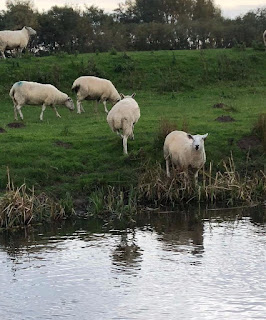Having the dogs with us
constrains the places we like to moor – specifically towns and cities where we
can’t let them out of the boat without their leads. This means both Wigan and
Manchester are big no-go areas. In addition we don’t really enjoy mooring
anywhere on the Leigh branch, either of the Bridgewater or of the L&L. The
banks are very high and steep, and in general it doesn’t feel friendly. So we
were reluctant to make a short trip through Wigan and then stop very early. On
the other hand we couldn’t just do a normal run, as that would mean mooring
somewhere in Stretford or Sale. So we decided to try for the double jump, and
see if we could blitz through both conurbations and get out into the country beyond
Sale. That would also give us an easy trip home tomorrow.









It was a beautiful clear day, and
in late October that meant a frost, with ice on the woodwork of the stern, and
mist rising from the canal as we set off, a beautiful sight. We made a good
start, getting up the first two locks with no problems, and as we approached
the third, after Wigan Pier, a C&RT workman, who was doing some maintenance
on the lock, waved us in and worked the whole thing so Loulie didn’t even have
to get off.
We did the final lock upwards in
Wigan, and then came to the junction and turned down the Leigh branch. Now we
were going downhill, and after dropping through the first lock with no trouble,
we came to the final one and found a widebeam just going in ahead of us. Although
it is a double width lock it can’t take anything else alongside a widebeam, so
we had to wait. Loulie took all four dogs and walked on ahead, while I waited
for them to finish, and then worked Eileen down on my own. It’s the first dock
I have done solo, and it is fine as long as you take care and think things
through, but there’s no doubt it takes longer.
I then set off in hot pursuit,
and picked up the landing party after a couple of miles. We were going as fast
as we dared, and we caught up with the widebeam at Planks Lane lift bridge,
where they were about to go through. As the wife was working the bridge and he
would have to pick her up after closing it we asked if they minded if we passed
by and headed on, as we were in a hurry.
Now there were no more locks or
bridges ahead of us, and virtually no traffic, so it was just a question of
keeping our speed as high as we could. The canal on this branch has high,
concrete or metal sides, so the usual concern about creating a wash and
damaging earth banks does not apply. The main cause of delay was moored boats,
where we had to slow down, of course. At first, looking at our Pearson’s Canal
Guide it seemed we had far too much to do, based on his time estimates for each
page of the route. However it turned out that he had been far too generous with
his estimates and we were taking much less time than forecast, so we could still just make it if we hurried.
We came through Leigh, then
through the open countryside until we reached Worsley, Barton and Trafford
Park. We arrived at Watersmeet a little before five, and now we were confident
that we would at least reach the countryside, if not our preferred spot by the
Bollin Aqueduct. Sale is long straight and boring, and the Sale Cruising Club
occupies a large percentage of the bank, obliging us to slow down often.
Eventually we got through and out into the open as the sun slipped below the
horizon.
We still had about twenty minutes
to go, but we resolved to reach the Bollin, and the twilight was OK for navigation,
especially as there were no other boats. Still, we had the headlight on by the
time we reached our mooring point, and tied up. It was about 6:40, and we had
covered 28.9 miles, easily our best for a single day. Scrambled eggs and bacon,
both from Yates Greer, rounded off a tough but fun day.
Today: 9.7 hours. 28.9 miles. 6 locks. 1 bridge.
Voyage: 48.2 hours.
108.4 miles. 30 locks. 26 bridges.
























































